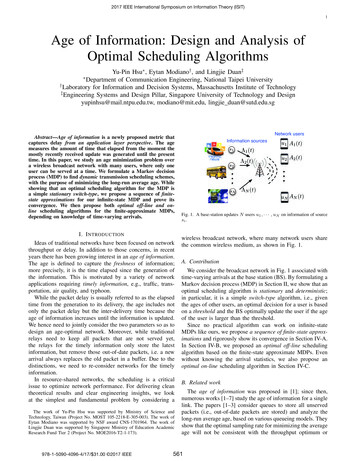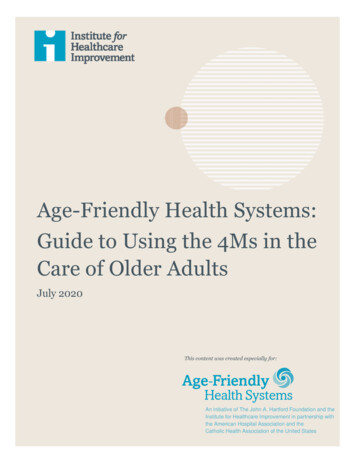
Transcription
2017 IEEE International Symposium on Information Theory (ISIT)1Age of Information: Design and Analysis ofOptimal Scheduling AlgorithmsYu-Pin Hsu , Eytan Modiano† , and Lingjie Duan‡ Department of Communication Engineering, National Taipei University† Laboratory for Information and Decision Systems, Massachusetts Institute of Technology‡ Engineering Systems and Design Pillar, Singapore University of Technology and Designyupinhsu@mail.ntpu.edu.tw, modiano@mit.edu, lingjie duan@sutd.edu.sgAbstract—Age of information is a newly proposed metric thatcaptures delay from an application layer perspective. The agemeasures the amount of time that elapsed from the moment themostly recently received update was generated until the presenttime. In this paper, we study an age minimization problem overa wireless broadcast network with many users, where only oneuser can be served at a time. We formulate a Markov decisionprocess (MDP) to find dynamic transmission scheduling schemes,with the purpose of minimizing the long-run average age. Whileshowing that an optimal scheduling algorithm for the MDP isa simple stationary switch-type, we propose a sequence of finitestate approximations for our infinite-state MDP and prove itsconvergence. We then propose both optimal off-line and online scheduling algorithms for the finite-approximate MDPs,depending on knowledge of time-varying arrivals.I. I NTRODUCTIONIdeas of traditional networks have been focused on networkthroughput or delay. In addition to those concerns, in recentyears there has been growing interest in an age of information.The age is defined to capture the freshness of information;more precisely, it is the time elapsed since the generation ofthe information. This is motivated by a variety of networkapplications requiring timely information, e.g., traffic, transportation, air quality, and typhoon.While the packet delay is usually referred to as the elapsedtime from the generation to its delivery, the age includes notonly the packet delay but the inter-delivery time because theage of information increases until the information is updated.We hence need to jointly consider the two parameters so as todesign an age-optimal network. Moreover, while traditionalrelays need to keep all packets that are not served yet,the relays for the timely information only store the latestinformation, but remove those out-of-date packets, i.e. a newarrival always replaces the old packet in a buffer. Due to thedistinctions, we need to re-consider networks for the timelyinformation.In resource-shared networks, the scheduling is a criticalissue to optimize network performance. For delivering cleantheoretical results and clear engineering insights, we lookat the simplest and fundamental problem by considering aThe work of Yu-Pin Hsu was supported by Ministry of Science andTechnology, Taiwan (Project No. MOST 105-2218-E-305-003). The work ofEytan Modiano was supported by NSF award CNS-1701964. The work ofLingjie Duan was supported by Singapore Ministry of Education AcademicResearch Fund Tier 2 (Project No. MOE2016-T2-1-173).978-1-5090-4096-4/17/ 31.00 2017 IEEE s1s2sN Λ1 (t)Λ2 (t)ΛN (t) u1 A1 (t)u2 A2 (t)uN AN (t)Fig. 1. A base-station updates N users u1 , · · · , uN on information of sourcesi .wireless broadcast network, where many network users sharethe common wireless medium, as shown in Fig. 1.A. ContributionWe consider the broadcast network in Fig. 1 associated withtime-varying arrivals at the base station (BS). By formulating aMarkov decision process (MDP) in Section II, we show that anoptimal scheduling algorithm is stationary and deterministic;in particular, it is a simple switch-type algorithm, i.e., giventhe ages of other users, an optimal decision for a user is basedon a threshold and the BS optimally update the user if the ageof the user is larger than the threshold.Since no practical algorithm can work on infinite-stateMDPs like ours, we propose a sequence of finite-state approximations and rigorously show its convergence in Section IV-A.In Section IV-B, we proposed an optimal off-line schedulingalgorithm based on the finite-state approximate MDPs. Evenwithout knowing the arrival statistics, we also propose anoptimal on-line scheduling algorithm in Section IV-C.B. Related workThe age of information was proposed in [1]; since then,numerous works [1–7] study the age of information for a singlelink. The papers [1–3] consider queues to store all unservedpackets (i.e., out-of-date packets are stored) and analyze thelong-run average age, based on various queueing models. Theyshow that the optimal sampling rate for minimizing the averageage will not be consistent with the throughput optimum or561
2017 IEEE International Symposium on Information Theory (ISIT)2delay optimum. The paper [4] considers a smart update andshows the always update scheme does not minimize theaverage age. Moreover, [5, 6] develop power-efficient updatingalgorithms for minimizing the average age. The model in [7]uses a small buffer to store the latest information.Of the most relevant work to us about scheduling formultiple users is [8–10]. Both [8, 9] consider queues at a BS,while [8] develops some hueristic scheduling algorithms and[9] analyzes the complexity of scheduling for minimizing theaverage age. The paper [10] considers a frame-based system,where all packets arrive at a BS at the beginning of each frame,while developing an index policy. Our work is the first one toconsider the age minimization problem with general arrivals,which can happen at any slot, and propose both optimal offline and on-line scheduling algorithms.II. S YSTEM MODELWe consider a network consisting of a base-station (BS), andN wireless users u1 , · · · , uN as illustrated in Fig. 1, whereeach user ui is interested in the information generated by anassociated source si . The information is transmitted throughthe BS in the form of packets. Our focus in this paper is onthe noiseless channels, where all transmissions from the BS toeach user are considered to be successful with a sufficientlyhigh probability, i.e., we ignore transmission errors. Please seeour technical report [11] for unreliable channels.We consider a discrete-time system with slots t 0, 1, · · · .The packets from the sources (if any) arrive at the BS atthe beginning of each slot. Without loss of generality, weassume that the BS can transmit at most one packet duringeach slot, i.e., the BS can update at most one user at each slot.We assume that the arrivals at the BS for different users areindependent of each other and also independent and identicallydistributed (i.i.d.) over slots, following a Bernoulli distribution.Precisely, by Λi (t), we indicate if a packet from source siarrives at the BS at slot t, in which Λi (t) 1 if there is apacket; otherwise, Λi (t) 0, where P [Λi (t) 1] pi .In the applications of interest in this paper, only the freshinformation is significant for the users; as such, the BS needsto buffer at most one packet for each user, i.e., an arrivingpacket always replaces the old one in the buffer. However, inthis paper we focus on the scenario without any buffer, wherethe arrivals are discarded if not transmitted in the current slot.The no-buffer system is simple for practical systems as wellas results in good performance in a single link (see [7]). In ourtechnical report [11], we have extended our results successfullyby considering the buffers. It turns out that the main resultshold for the buffer-network; moreover, the performance of theno-buffer system is very close to the buffer-network.A. Age of information modelThe age of information represents the freshness of theinformation at the users. We assume that the ages of thepackets are zero when reaching the BS. On receiving a packet,the age of information for the user is reset to be one due toone slot of the transmission time.Let Ai (t) be the age of information for user ui at slott before the BS makes a decision. Considering a linearlyincreasing age over slots, the age of user ui at slot t isAi (t) t ri (t), where ri (t) is the time that the most recentlyreceived packet by user ui was generated.We remark that since the BS can update at most one userfor each slot, Ai (t) 1 for all i, Ai (t) Aj (t) for all i j, Nand i 1 Ai (t) 1 2 · · · N for all t.B. Markov decision process modelWe use a Markov decision process (MDP) to developscheduling algorithms for the BS to update a user at eachtransmission opportunity. According to [12], we describe thecomponents of our MDP in detail below.Decisions and decision epochs: For each slot, the BS makesa decision immediately after receiving packets. By D(t) {0, 1, · · · N } we denote a decision of the MDP at slot t, whereD(t) 0 if the BS does not transmit any packet and D(t) ifor i 1, · · · , N if user ui is scheduled to be updated at slott. Considering the no-buffer network, for each slot the BSupdates a user with an arrival at the BS, i.e., D(t) {i :Λi (t) 1}. Note that the action-space is finite.States: We define the state S(t) of the system at slot tas S(t) (A1 (t), · · · , AN (t), Λ1 (t), · · · , ΛN (t)). By S wedefine the state-space including all possible states. Note thatS is a countable infinite set because the ages are possiblyunbounded.Transition probabilities: Under decision D(t) d, asthe transmission time is one slot, the age of the nextslot is Ad (t 1) 1 and Ai (t 1) Ai (t) 1 for i d. Let Ps,s (d) be the transition probabilityfrom state s (a1 , · · · , aN , λ1 , · · · , λN ) to state s (a 1 , · · · , a N , λ 1 , · · · , λ N ) under decision D(t) d, and thenthe probability law is Πi:λ i 1 pi Πi:λ i 0 (1 pi ) if a d 1 and Ps,s (d) a i ai 1 for i d; 0else.Cost: Let C(S(t), D(t) d) be the immediate cost ifdecision D(t) d is taken at slot t under system state S(t).We consider the total age of the system after making a decisionat slot t:C(S(t), D(t) d) N i 1N Ai (t 1)(Ai (t) 1) Ad (t) · Λd (t),i 1where we define A0 (t) 0 and Λ0 (t) 0 for all t (for thecase of d 0), while the last term indicates that user ud isupdated at slot t. We remark that our analysis and design canalso work perfectly with the weighted sum of the ages.C. Average-optimal scheduling algorithm designA scheduling algorithm θ specifies decisions at all decision epochs, i.e., θ {D(1), D(2), · · · }. An algorithm ishistory dependent if D(t) depends on D(1), · · · , D(t 1)and S(1) · · · , S(t), while it is Markov if D(t) only dependson S(t). An algorithm is stationary if D(t1 ) D(t2 )562
2017 IEEE International Symposium on Information Theory (ISIT)3when S(t1 ) S(t2 ) for any t1 , t2 . Moreover, A randomizedalgorithm specifies a probability distribution on the set of actions for each decision epoch, while a deterministic algorithmchooses an action with certainty.The long-run average cost for some history dependentalgorithm θ is given by T 1V (θ) lim supEθC(S(t), D(t)) S(0) ,T T 1t 0where Eθ represents the conditional expectation, given thatthe policy θ is employed.Definition 1. A scheduling algorithm θ is average-optimal ifit minimizes the long-run average cost V (θ).Our goal is to characterize and obtain an average-optimalalgorithm. However, according to [12], there may not exist astationary or deterministic algorithm that is average-optimalfor an infinite state-space MDP. Due to the space limitation,we present our main results in this paper, and please see ourtechnical report in [11] for the complete proofs.III. C HARACTERIZATIONS OF THE AVERAGE - OPTIMALITYWe begin with an infinite horizon α-discounted cost case,where 0 α 1; we then tie to the average cost case becausestructures of the average-optimal algorithm usually rely on thediscounted cost case. Given initial state S(0) s, the totalexpected discounted cost under an algorithm θ is T tVα (s; θ) lim Eθα C(S(t), D(t)) S(0) s .T t 0Definition 2. A scheduling algorithm θ is α-optimal if itminimizes the total expected discounted cost Vα (s; θ). Inparticular, we defineVα (s) min Vα (s; θ).θWe first introduce the discounted cost optimality equationfor Vα (s) as below.Proposition 3. The optimal expected discounted cost Vα (s),for state s, satisfies the following discounted cost optimalityequation:Vα (s) mind {0,1,··· ,N }C(s, d) αE[Vα (s )],(1)where the expectation is taken over all possible next state s reachable from the state s. A deterministic stationary algorithm that realizes the minimum of the right hand side (RHS)of the discounted cost optimality equation will be an α-optimalalgorithm. Moreover, we define Vα,n (s) by Vα,0 (s) 0 andfor any n 0Vα,n 1 (s) mind {0,1,··· ,N }C(s, d) αE[Vα,n (s )].(2)Then, Vα,n (s) Vα (s) as n for every s, and α.Proof. (Sketch) Basically, we need to verify that Vα (s) is finitefor all possible α and s. Please see [11] for details.Lemma 4. There exists a deterministic stationary algorithmthat is average-optimal. Moreover, there exists a finite constantg limα 1 (1 α)Vα (s) for every state s such that theaverage-optimal cost is g, independent of the initial state S(0).Proof. Please see [11].We remark that even though the average-optimality of adeterministic stationary algorithm is shown in Lemma 4, wemight not arrive at an average cost optimaility equation likeEq. (1) or the value iteration like Eq. (2) (see [13, 14] fordetails).In addition to the average-optimality of a deterministic stationary algorithm, we show that an average-optimal schedulingalgorithm has a nice structure facilitating the scheduling algorithm design in the next section.Definition 5. A switch-type algorithm is a deterministic stationary algorithm: for every user ui , if an average-optimaldecision for state s (a1 , · · · , ai , · · · , aN , λ1 , · · · , λN ) isd s i, then an optimal decision at state s (a1 , · · · , ai 1, · · · , aN , λ1 , · · · , λN ) is d s i as well.Theorem 6. An average-optimal scheduling algorithm is theswitch-type algorithm.Proof. (Sketch) We first prove that an α-optimal schedulingalgorithm is the switch-type by applying the value iteration inEq. (2). Then, we show that the structure holds for the averageoptimum by letting α 1. Please see [11] for details.In particular, if the arrival rates of all information sourcesare the same, we can obtain a nice index algorithm as follows.Corollary 7. If the arrival rates of all information sourcesare the same, i.e., pi pj for all i j, then an optimalscheduling algorithm updates the user with the largest age,i.e., D(t) arg maxi Ai (t) for each time t.Proof. Please see [11].We also notice that the index algorithm is indeed an on-linealgorithm, without the knowledge of the arrival statistics inadvance. For general asymmetric arrivals, an average-optimalscheduling algorithm depends on both the arrival statistics andthe current ages. However, it is not obvious how to get anaverage-optimal scheduling for the asymmetric arrivals. Thiskey challenge hence motivates us to investigate both off-lineand on-line scheduling algorithms in the next section.IV. S CHEDULING ALGORITHM DESIGNWe start with proposing finite-state approximations to theoriginal MDP as in practice we can only work on a finitestate MDP to avoid formidably high computation complexity.We will rigorously show the convergence of the proposedtruncation as in general a MDP truncation might not convergeto the original MDP according to [14].Based on the finite-state MDPs, we first propose a structuralvalue iteration algorithm in Section IV-B to pre-compute anoptimal decision for each state, whose complexity wouldbe lower than the conventional value iteration algorithm byemploying the switch structure. Moreover, we propose an online algorithm leveraging the stochastic approximation [15] inSection IV-C563
2017 IEEE International Symposium on Information Theory (ISIT)4A. Finite-state MDP approximationsAlgorithm 1: Structural off-line scheduling algorithmLet Δ be the Markov decision process defined in Section II-B. By {Δm } we define a sequence of approximateMDPs for Δ whose state-space is Sm {s S : ai m}with the bounded virtual ages, while the decision-space andcost definition are the same as Δ.(m)Let Ai (t) be the age of information for user ui at time tfor Δm . Different from Δ, under decision D(t) d the age(m)(m)of the next slot for Δm is Ad (t 1) 1 and Ai (t 1) (m) if i d, where we define the notation [x] Ai (t) 1mm by [x] m x if x m and [x]m m if x m.(m)Let Ps,s (d) be the transition probability for Δm . Then,(m)Ps,s (d) Ps,s (d) if s Sm ; otherwise, (m)Ps,r (d),Ps,s (d) Ps,s (d) r S Smfor some excess probabilities on state r S Sm .Next, we show that the proposed finite-state approximationswill be asymptotically average-optimal.Theorem 8. Let V and Vm be the average-optimal cost toΔ and Δm , respectively. Then, Vm V as m .Proof. Please see [11].Now, we are ready to propose scheduling algorithms basedon Δm . In other words, the BS make decisions according to(m)the virtual age Ai (t) on Sm , instead of the real age Ai (t)on S. The real age can increase beyond m but the virtual agewill be smaller than m 1.B. Structural off-line scheduling algorithmThe relative value iteration algorithm (RVIA), as follows,can be applied to get an optimal deterministic stationaryalgorithm on Δm :Vn 1 (s) mind {0,1,··· ,N }C(s, d) E[Vn (s )] Vn (0),(3)for all s Sm , where 0 is a reference state and we can arbitrarily choose the reference state by 0 (1, 2, · · · , N, 1, · · · , 1).For each iteration n, we need to update the decisions for allvirtual states by minimizing the RHS of Eq. (3) as well asupdate V (s) for all s Sm . The complexity is very high dueto many users (i.e., curse of dimensionality [16]). Therefore,we propose in Alg. 1 a structural off-line algorithm based onthe RVIA along with the switch structure.In Alg. 1, we seek an optimal decision d s for each virtualstate s Sm by iteration. For each iteration, we update bothoptimal decision d s and V (s) for all virtual states. If theswitch property holds, we can determine an optimal decisionimmediately in Line 5; otherwise we find an optimal decisionaccording to Line 7. By Vtmp (s) in Line 9 we temporarilykeep the updated value, which will replace V (s) in Line 11.Using the switch structure to prevent from the minimumoperations on all virtual states in the RVIA, we can reducethe computational complexity accordingly. We conclude theoptimality of Alg. 1 in the following.123456789101112V (s) 0 for all states s Sm ;while 1 doforall s (a1 , · · · , ai , · · · , aN , λ1 , · · · , λN ) Sm doif there exists ζ 0 and i {1, · · · , N } such thatd (a ,··· ,a ζ,··· ,a ,λ ,··· ,λ ) i then11iNNd s i;elsed s arg mind {0,1,··· ,N } C(s, d) E[V (s )];endVtmp (s) C(s, d s ) E[V (s )] V (0);endV (s) Vtmp (s) for all s Sm .endTheorem 9. The limit point of d s of Alg. 1 is an averageoptimal decision for all virtual state s Sm . In particular,Alg. 1 converges in a finite number of iterations.Proof. (Sketch) We need to verify that the finite-state approximate MDPs are unichain. Please see [11] for details.C. On-line scheduling algorithmWe notice that Alg. 1 needs the arrival statistics to precompute an optimal decision for each virtual state. We willpropose an on-line scheduling algorithm in case that thestatistics is unavailable. Instead of updating V (s) for all statesat each iteration, we update V (s) following a sample path,which is a set of outcomes of the arrivals over slots. It turnsout that the sample-path updates will converge to the averageoptimal solution.To that end, we need a stochastic version of the RVIA.However, the RVIA in Eq. (3) is not suitable because theexpectation is inside the minimization (see [16] for details).Moreover, minimizing the RHS of Eq. (3) for a given currentstate needs the transition probabilities to calculate the expectation. To tackle these challenges, we design post-decisionstates [16] for our problem.We define the post-decision state s̃ as the ages andthe arrivals after a decision. The state we used before is referred to as the pre-decision state. If s (a1 , · · · , aN , λ1 , · · · , λN ) Sm is a virtual state of thesystem, then the virtual post-decision state after decision dis s̃ (ã1 , · · · , ãN , λ̃1 , · · · , λ N ), where ãi 1 if i d and ãi [ai 1]m otherwise, as well as λ̃i λi for all i.Let Ṽ (s̃) be a value function based on the post-decisionstates:Ṽ (s̃) Es [V (s)],where the expectation Es is taken over all the predecision states reached from the post-decision state. Wecan then write down the post-decision average cost optimality equation [16] for the virtual post-decision age s̃ (ã1 , · · · , ãN , λ̃1 , · · · , λ̃N ) with s̃ Sm :564Ṽ (s̃) g Emind {0,1,··· ,N } C (ã, λ̃ ), d Ṽ ([ã 1 ãd ] m , λ̃ ) ,
2017 IEEE International Symposium on Information Theory (ISIT)52345D (t) arg mind {0,1,··· ,N } Ṽ ([ã 1 78910(5)where ãi (0, · · · , ãi , · · · , 0) is the zero vector except forthe i-th entry being substituted by ãi , and 1 (1, · · · , 1) isthe unit vector. Moreover, λ̃ is the next possible arrivals.From above optimality equation, the RVIA is as follows:Ṽn 1 (s̃) Emind {0,1,··· ,N }C (ã, λ̃ ), d Ṽn ([ã 1 Ṽn (0). ad ] m , λ̃ ) (4)Then, we are ready to propose the on-line algorithm inAlg. 2 based on a stochastic version of the RVIA. In Lines 1-3,we initialize Ṽ (s̃) of all virtual post-decision states and startfrom the reference point. Moreover, by v we record Ṽ (s̃) ofthe current virtual post-decision state.By observing the current arrivals Λ(t) and plugging inEq. (4), in Line 5 we optimally update a user by minimizingEq. (5); as such, the expectation in Eq. (4) is removed. Then,we update Ṽ (s̃) of the current virtual post-decision state inLine 7, where γ(t) is a stochastic step-size (see [16]) at slott and hence Ṽ (s̃) is balanced between the previous Ṽ (s̃) andthe current value v. Finally, the next virtual post-decision stateis updated in Lines 8 and 9. Theorem 10. If t γ(t) and t γ 2 (t) , then Alg. 2converges to the average-optimal value.Proof. Please see [11].43.5On line algorithmOff line algorithm111098760.40.50.60.70.8Arrival rate (p)0.90.40.50.60.70.8Arrival rate (p)0.9Fig. 2. The average total age over 100,000 slots versus the symmetric arrivals(i.e., pi p for all user ui ) by employing Algs. 1 and 2 for two users (leftfigure) and three users (right figure).end 54.52.5/* Value update */v C ((ã, Λ(t)), D (t)) Ṽ ([ã 1 ãD (t) ] m , Λ(t)) Ṽ (0);Ṽ (s̃) (1 γ(t))Ṽ (s̃) γ(t)v;/* Post-decision state update */ã [ã 1 ãD (t) ] m;λ̃ Λ(t).65.53C ((ã, Λ(t)), d)ãd ] m , Λ(t));On line algorithmOff line algorithm6Average total age16.5/* Initialization */Ṽ (s̃) 0 for all states s̃ Sm ;s̃ 0;v 0;while 1 do/* Decision at slot t */We optimally make a decision D (t) at slot t according to thecurrent arrivals Λ(t) (Λ1 (t), · · · , ΛN (t) at slot t:Average total ageAlgorithm 2: On-line scheduling algorithm In the above theorem,t γ(t) implies that Alg. 2needs infinite number of iterations to learn the average-optimalsolution, while Alg. 1 can converge to the optimal solution ina finite number of iterations. Moreover, t γ 2 (t) meansthat the noise from measuring Ṽ (s̃) can be controlled.Finally, we want to emphasize that the proposed Algs. 1 and2 are asymptotically optimal, i.e., they converge to the optimalsolutions when the finite state-space m and the slots t go toinfinity. In Fig. 2, we show the performance of Algs. 1 and 2over finite slots. In our technical report [11], we provide morenumerical studies and discussions of the proposed algorithmsfor both no-buffer network and buffer-network.V. C ONCLUSIONIn this paper, we consider a broadcast network, wheremany users are interested in different information that shouldbe delivered by a base-station. We theoretically investigatethe long-run average age of information by designing andanalyzing optimal scheduling algorithms. We show that anoptimal scheduling algorithm is a simple stationary switchtype. To tackle the infinite state-space Markov decision process(MDP), we propose a sequence of finite-state approximateMDPs. Based on the approximate MDPs, we propose bothoff-line and on-line scheduling algorithms. It turns out theproposed algorithms are asymptotically optimal.R EFERENCES[1] S. Kaul, R. D. Yates, and M. Gruteser, “Real-Time Status: How OftenShould One Update?” Proc of IEEE INFOCOM, pp. 2731–2735, 2012.[2] C. Kam, S. Kompella, G. D. Nguyen, and A. Ephremides, “Effect ofMessage Transmission Path Diversity on Status Age,” IEEE Trans. Inf.Theory, vol. 62, no. 3, pp. 1360–1374, 2016.[3] L. Huang and E. Modiano, “Optimizing Age-of-Information in a MultiClass Queueing System,” Proc. of IEEE ISIT, pp. 1681–1685, 2015.[4] Y. Sun, E. Uysal-Biyikoglu, R. D. Yates, C. E. Koksal, and N. B.Shroff, “Update or Wait: How to Keep Your Data Fresh,” Proc. of IEEEINFOCOM, pp. 1–9, 2016.[5] R. D. Yates, “Lazy is Timely: Status Updates by an Energy HarvestingSource,” Proc. of IEEE ISIT, pp. 3008–3012, 2015.[6] B. T. Bacinoglu, E. T. Ceran, and E. Uysal-Biyikoglu, “Age of Information under Energy Replenishment Constraints,” Proc. of ITA, pp. 25–31,2015.[7] M. Costa, M. Codreanu, and A. Ephremides, “On the Age of Informationin Status Update Systems with Packet Management,” IEEE Trans. Inf.Theory, vol. 62, no. 4, pp. 1897–1910, 2016.[8] L. Golab, T. Johnson, and V. Shkapenyuk, “Scalable Scheduling ofUpdates in Streaming Data Warehouses,” IEEE Trans. Knowl. Data Eng.,vol. 24, no. 6, pp. 1092–1105, 2012.[9] Q. He, D. Yuan, and A. Ephremides, “Optimizing Freshness of Information: On Minimum Age Link Scheduling in Wireless Systems,” Proc.of WiOpt, pp. 1–8, 2016.[10] I. Kadota, E. Uysal-Biyikoglu, R. Singh, and E. Modiano, “MinimizingAge of Information in Broadcast Wireless Networks,” Proc. of Allerton,2016.[11] Y.-P. Hsu, E. Modiano, and L. Duan, “Age of Information: Design andAnalysis of Optimal Scheduling Algorithms,” Technical report, 2017.[Online]. Available: http://web.ntpu.edu.tw/%7Eyupinhsu/age.pdf[12] M. L. Puterman, Markov Decision Processes: Discrete Stochastic Dynamic Programming. The MIT Press, 1994.[13] L. I. Sennott, “Average Cost Optimal Stationary Policies in InfiniteState Markov Decision Processes with Unbounded Costs,” OperationsResearch, vol. 37, pp. 626–633, 1989.[14] ——, Stochastic Dynamic Programming and the Control of QueueingSystems. John Wiley & Sons, 1998.[15] V. S. Borkar, Stochastic Approximation: A Dynamical Systems Viewpoint. Cambridge University Press, 2008.[16] W. B. Powell, Approximate Dynamic Programming: Solving the Cursesof Dimensionality. John Wiley & Sons, 2011.565
algorithms for minimizing the average age. The model in [7] uses a small buffer to store the latest information. Of the most relevant work to us about scheduling for multiple users is [8-10]. Both [8, 9] consider queues at a BS, while [8] develops some hueristic scheduling algorithms and [9] analyzes the complexity of scheduling for .











